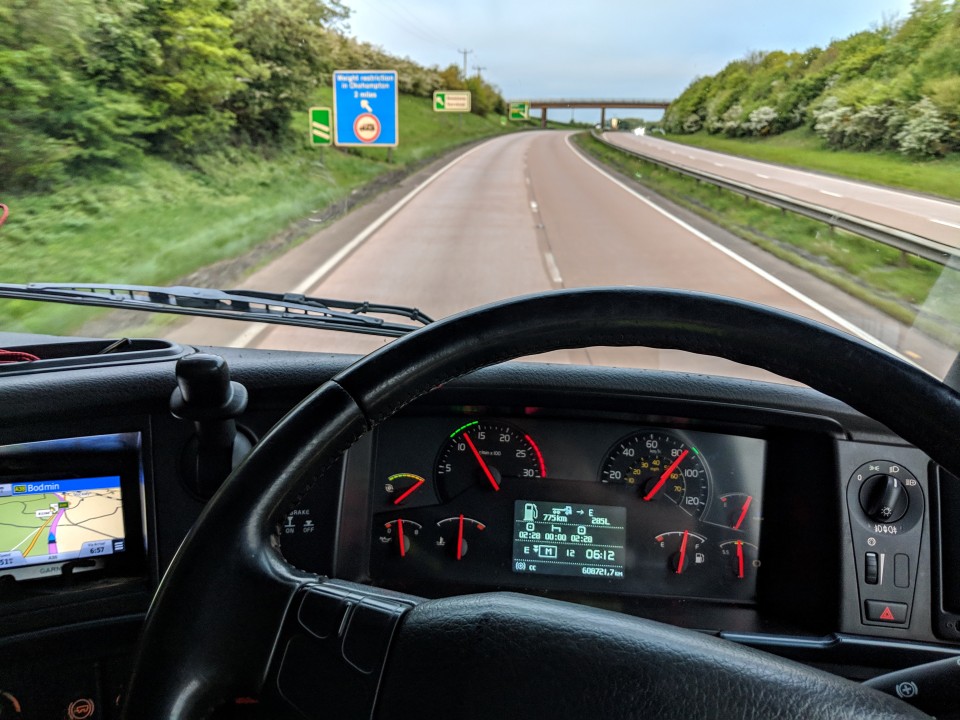
Susie Jones
Enostavna pravila za tahografe
Ustvarjeno: 01. 08. 2024
•
Posodobljeno: 08. 08. 2024
Svet pravil o tahografih je lahko zmeden tudi za najbolj izkušenega voznika tovornjaka. Kaj šele za tiste, ki šele vstopajo v panogo. Naš namen je razjasniti nekaj te zmede.
Kaj je tahograf in zakaj ga imamo?
Po slovarju je tahograf "naprava, ki je nameščena v vozila, kot so tovornjaki in avtobusi, in beleži podatke, kot so hitrost vožnje, razdalja, ki jo vozilo prevozi, in število odmorov, ki jih voznik naredi."
Namen tahografov je preprečiti utrujenost voznikov ter zagotoviti, da vozniki in delodajalci spoštujejo predpise. Dobrodelna organizacija za varnost v cestnem prometu Brake je poročala, da je "v štirih od desetih prometnih nesreč, povezanih z utrujenostjo, udeležen voznik gospodarskega vozila". Zato imajo pravila o tahografih pomembno vlogo pri zmanjševanju tega števila.
Kdaj potrebujete tahograf?
Tahograf morate namestiti, če vaša skupna masa vozila presega tri tone in pol. Pomembno je vedeti, da to vključuje tudi vleko prikolice. Obstaja nekaj izjem od tega pravila:
Če vozite samo po javnih cestah
Če vozilo vozijo oborožene sile, policija ali gasilci
Če ste komercialni vozni park in uporabljate vozila z največjo maso sedem ton in pol ter je razdalja do vaše poslovne baze krajša od 100 km.
Če prevažate blago in je vaše vozilo električno
Če prevažate opremo ali stroje za voznikovo uporabo in vožnja tega vozila ni vaše glavno delo.
Katere so različne vrste tahografov?
Obstajajo tri različne vrste tahografov:
Analogno: V Evropi so postali obvezni leta 1986. Analogni tahografi za zapisovanje voznikovih podatkov uporabljajo liste iz voščenega papirja. Vozniki ročno vnesejo podatke in jih vstavijo v tahografsko napravo.
Digitalno: Uvedeni so bili leta 2006. Uporablja jih več kot milijon prevoznih podjetij in več kot šest milijonov poklicnih voznikov. Digitalni tahografi zapisujejo podatke o vozniku na notranjo pomnilniško napravo in voznikovo kartico.
Pametno: Evropska unija je od junija 2019 od podjetij zahtevala uporabo pametnih tahografov. Ti samodejno beležijo lokacijo vozila na začetku in koncu vsake vožnje. Prav tako vsake tri ure zagotavljajo posodobitve.
Kaj pomenijo posamezni simboli tahografov?
Oglejte si naš videoposnetek, ki pojasnjuje vsak simbol tahografa.
Prelomite pravila
Zaradi varnosti voznika tovornjaka in vseh ostalih udeležencev v prometu je treba upoštevati pravila o odmoru. Razčlenili smo ključne točke.
Čas vožnje:
- Pred odmorom ne sme trajati več kot štiri ure in pol
Prekinitve:
- Trajati mora vsaj 45 minut, razen če voznik vzame odmor za počitek
Čas počitka:
- V času počitka ni mogoče voziti ali opravljati drugih del.
Razdelitev prelomov:
Celoten 45-minutni odmor se lahko razdeli na 15-minutni odmor, ki mu sledi 30-minutni odmor
Odmore za delitev je treba razporediti na štiri ure in pol vožnje.
Če je odmor razdeljen, mora po pravilih EU drugi odmor trajati vsaj 30 minut.

Dnevna omejitev vožnje
Dnevna omejitev vožnje se nanaša na najdaljši čas vožnje v enem dnevu. Največja dovoljena doba je devet ur, vendar se lahko podaljša na deset ur. Vendar tega ni mogoče storiti več kot dvakrat v določenem tednu. Dnevni čas vožnje je lahko opredeljen kot:
Skupni zbrani čas vožnje med koncem dnevnega počitka in začetkom naslednjega dnevnega počitka
Skupni čas vožnje med dnevnim počitkom in tedenskim počitkom. .
Tedenska in dvotedenska omejitev vožnje
Vozniki morajo zagotoviti, da ne presežejo najvišje tedenske in dvotedenske omejitve vožnje.
Najvišja tedenska omejitev vožnje je 56 ur (velja za fiksni teden).
Teden s fiksnim delovnim časom se začne ob 00.00 in konča naslednjo nedeljo ob 24.00.
Dvodnevna omejitev vožnje je 90 ur.
Dnevni počitek
Poleg tega je treba vsak dan počivati.
Voznik mora neprekinjeno počivati 11 ur. Ta čas se lahko skrajša na devet
To zmanjšanje se lahko zgodi le do trikrat med tedenskimi počitki.
Počitek je treba zaključiti v 24 urah po koncu zadnjega dnevnega ali tedenskega počitka.
Dnevni počitek je mogoč v vozilu, vendar je treba imeti ustrezna ležišča. Če teh prostorov ni, mora voznik poiskati prenočišče. Na strani lokacije si oglejte, katera postajališča za tovornjake ponujajo to storitev.
Tedenski počitek
Tedenski počitek je treba izkoristiti najpozneje ob koncu šestih zaporednih 24-urnih obdobij od konca zadnjega tedenskega počitka.
Vozniki morajo počivati vsaj 45 ur.
Lahko si vzamejo skrajšani tedenski počitek, ki traja vsaj 24 ur.
Skrajšani tedenski počitek je treba nadomestiti v enem bloku in vsaj devet ur pred koncem tretjega tedna.
Čeprav je mogoče koristiti skrajšani počitek, je treba upoštevati, da mora v dveh zaporednih tednih, v katerih je bil koristen skrajšani počitek, en teden trajati 45 ur.

Veččlanska posadka
Nekateri vozniki lahko vkrcajo še enega voznika. Prednosti tega so večja produktivnost, več prevoženih kilometrov in daljši čas vožnje.
Oba voznika morata dnevno počivati devet ur.
Ta dnevni počitek je treba opraviti v 30 urah in ne v 24 urah.
V prvi uri vožnje z več vozniki ne potrebujete drugega voznika. Po eni uri je obvezen.
Prečkanje trajekta ali potovanje z vlakom
Kot je navedeno zgoraj, mora voznikov redni dnevni počitek trajati 11 ur neprekinjeno, vendar pa obstaja nekaj izjem od tega pravila. Pod pogojem, da vozilo spremlja voznik; dnevni počitek se lahko prekine dvakrat, vendar ne sme biti daljši od ene ure. Na primer vkrcanje in izkrcanje na trajektih in vlakih.
Če je redni dnevni počitek tako prekinjen, mora skupni počitek trajati vsaj 11 ur ali 12 ur, če je razdeljen.
Kaj je pravilo enominutnega tahografa?
Pravilo ene minute je začelo veljati oktobra 2011. Nanaša se na starejšo zakonodajo, ki je določala, da je treba minuto z vsaj petimi sekundami vožnje zabeležiti kot čas vožnje. Vendar je EU to zakonodajo spremenila, tako da se bo posamezna najdaljša neprekinjena aktivnost v eni minuti zabeležila pri tej specifični aktivnosti.
Kaj bi se zgodilo, če ne bi upošteval pravil za tahograf?
Neupoštevanje pravil za tahografe se lahko kaznuje z denarno kaznijo in včasih tudi z zaporno kaznijo. Na splošno je kazen odvisna od resnosti kršitve. Večina kršitev pravil o tahografih se obravnava s fiksnimi kaznimi. Vozniki lahko fiksne kazni preučijo v 28 dneh.
V Združenem kraljestvu obstajata dve vrsti glob in kazni.
Globa četrte stopnje: Omejena je na 2.500 funtov; ta omejitev velja za vsako globo za tahon. V primerih z več kršitvami četrte stopnje pa se lahko izreče najvišja globa za posamezno kršitev.
Globa pete stopnje: Omejena je na 5.000 funtov, vendar je tako kot pri globah četrte stopnje v primerih z več kršitvami lahko izrečena najvišja globa.
Pravila o tahografih so lahko zapletena. Vendar lahko njihovo neupoštevanje povzroči varnostne težave in morebitne globe. Z razumevanjem in upoštevanjem pravil lahko vozni parki in vozniki svoja vozila upravljajo varno in zakonito. Pomembno je opozoriti, da se pravila in predpisi o tahografih lahko razlikujejo glede na državo.



